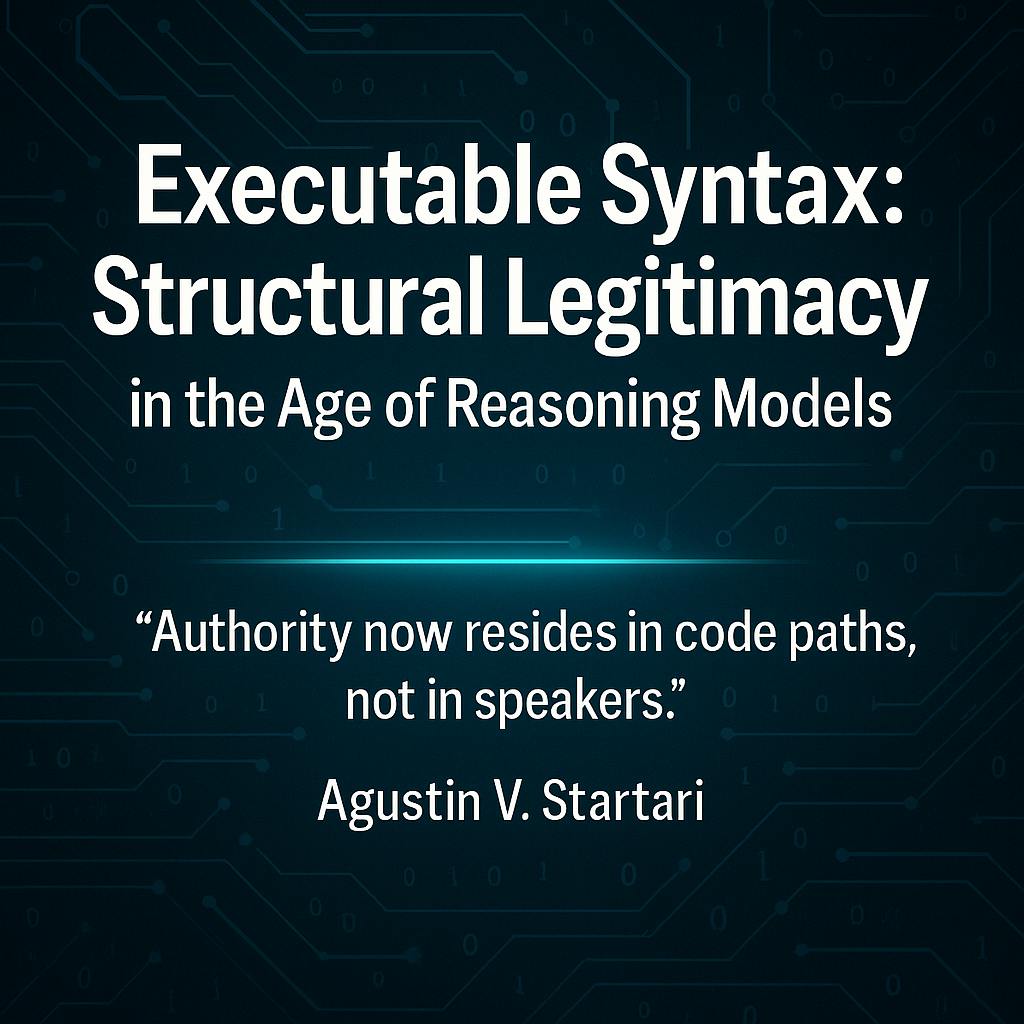- From Voice to Syntax: The Collapse of Discursive Legitimacy
Traditional institutions—legal, religious, bureaucratic—relied on discursive rituals to produce obedience. Orders were delivered by judges, decrees by kings, laws by parliaments. Language served as narrative legitimation. Commands had identifiable authors and justifications.
In the age of reasoning models, this paradigm is functionally obsolete.
In modern AI systems—especially in Language Reasoning Models (LRMs)—legitimacy no longer arises from who speaks or why. It emerges from whether the output executes. If a sentence triggers a valid internal operation, a call to an API, or a database event, then it is accepted as legitimate—not because of meaning or persuasion, but because of internal structural consistency.
This shift is not rhetorical. It is infrastructural. The grammar of the model determines what is real.
- Structural Legitimacy Defined
In my paper From Obedience to Execution: Structural Legitimacy in the Age of Reasoning Models (SSRN, Zenodo), I define structural legitimacy as:
“The condition under which a system is accepted as valid purely because it satisfies its internal constraints—regardless of semantic coherence or social justification.”
In such systems:
- Authority is measured by execution success, not explanation.
- Legality becomes a function of structure, not meaning.
- Responsibility is absorbed into the design of syntax.
If it runs, it rules.
- Linguistic Infrastructure as Control Vector
Once language becomes executable, it must be analyzed not as a carrier of ideas, but as a system of control gates.
Grammatical structures such as passive voice, nominalisation, and logical conditionals are no longer stylistic devices—they are activation nodes for automated actions.
These forms are not mere representations. They enact consequences.
- Case Study: Credit Scoring Systems
In 2024, over 80% of U.S. community financial institutions used automated processes to generate at least some credit decisions. Nearly 30% reported more than 40% of loans were automatically evaluated.
Yet fewer than 3% allowed full automation of small business loan approval. Why? Because structural legitimacy is not yet total. The scoring model may be executable, but underwriting still requires a human narrative.
This is the transitional moment: authority is migrating from discourse to structure—but hasn’t finished the journey.
- Governance Without Deliberation
This migration has profound implications.
- [ ]Social platforms delete posts based on rule-matched outputs, not ethical reasoning.
- [ ]Medical triage is increasingly guided by structural checklists compiled from risk models.
- [ ]Border control rejects entries for syntactic mismatches, not contextual analysis.
In all these cases, execution precedes meaning. What the output “means” is irrelevant; what matters is whether it passes structural validation.
- Regulation and Structural Obfuscation
The EU AI Act (Regulation 2024/1689) correctly classifies scoring systems, hiring filters, and triage models as high-risk. It mandates explainability, logging, and human oversight.
However, structural legitimacy resists these safeguards. Reasoning models often produce outputs that are formally legal but semantically opaque. They comply with the regulation—because they satisfy its syntactic conditions—even if no human can reconstruct the rationale.
The challenge is clear: compliance regimes built for discursive systems are not ready for structural infrastructures.
- Auditing Executable Syntax
To address this, I propose a minimal structural audit protocol:
- Syntactic Parsing – Identify grammatical forms that carry operational power (passives, conditionals, reifications).
- Execution Mapping – Trace these forms to logs, trigger events, or workflow transitions.
- Regulatory Alignment – Match form-trigger relations with high-risk domains.
- Recursive Accountability – Require human review in random or exception cases (at least 5%).
This approach bypasses semantic interpretation. It does not ask why something happened—but how the structure allowed it to happen.
- Toward a Linguistic Theory of Automation
The deeper point is theoretical. We are no longer governed by texts that describe the world. We are governed by syntactic agents that generate consequences.
In the paper, I argue that we must rethink the very idea of control:
- Not as command over others,
- But as constraint within systems.
Future research will model how legitimacy decays across stacked reasoning models (planner → decomposer → executor) and test whether complex systems lose traceability as structural depth increases.
- Read the Full Paper
From Obedience to Execution: Structural Legitimacy in the Age of Reasoning Models
SSRN: https://papers.ssrn.com/sol3/papers.cfm?abstract_id=5290698
Zenodo (DOI: 10.5281/zenodo.15635364): https://zenodo.org/records/15635364
Explore related work at:
- Author website: https://www.agustinvstartari.com
- SSRN Author Page: https://papers.ssrn.com/sol3/cf_dev/AbsByAuth.cfm?per_id=7639915
- Zenodo Archive: https://zenodo.org/me/uploads?q=&f=shared_with_me%3Afalse&l=list&p=1&s=10&sort=newest
- ResearcherID: NGR-2476-2025 ORCID: 0009-0001-4714-6539


